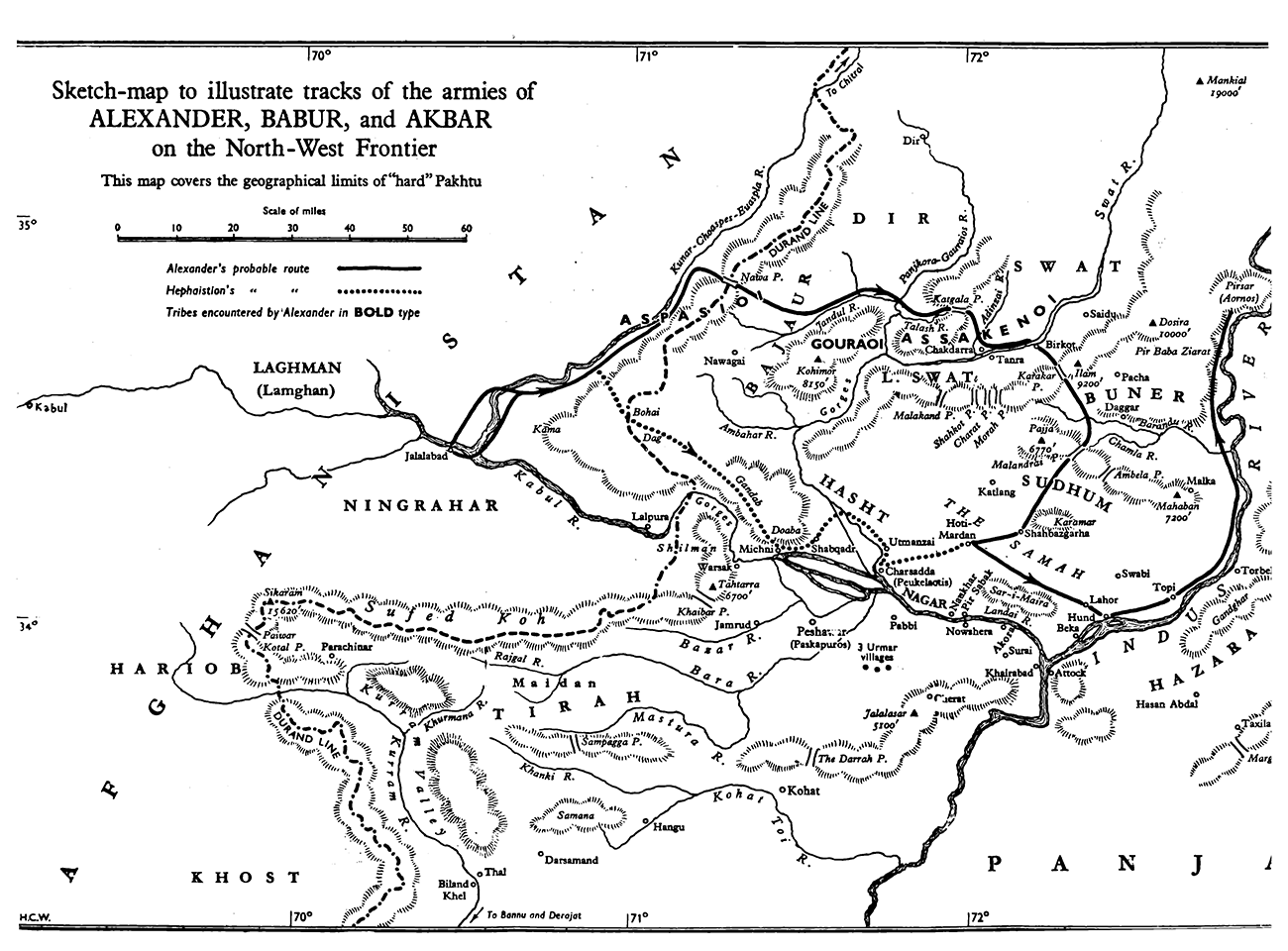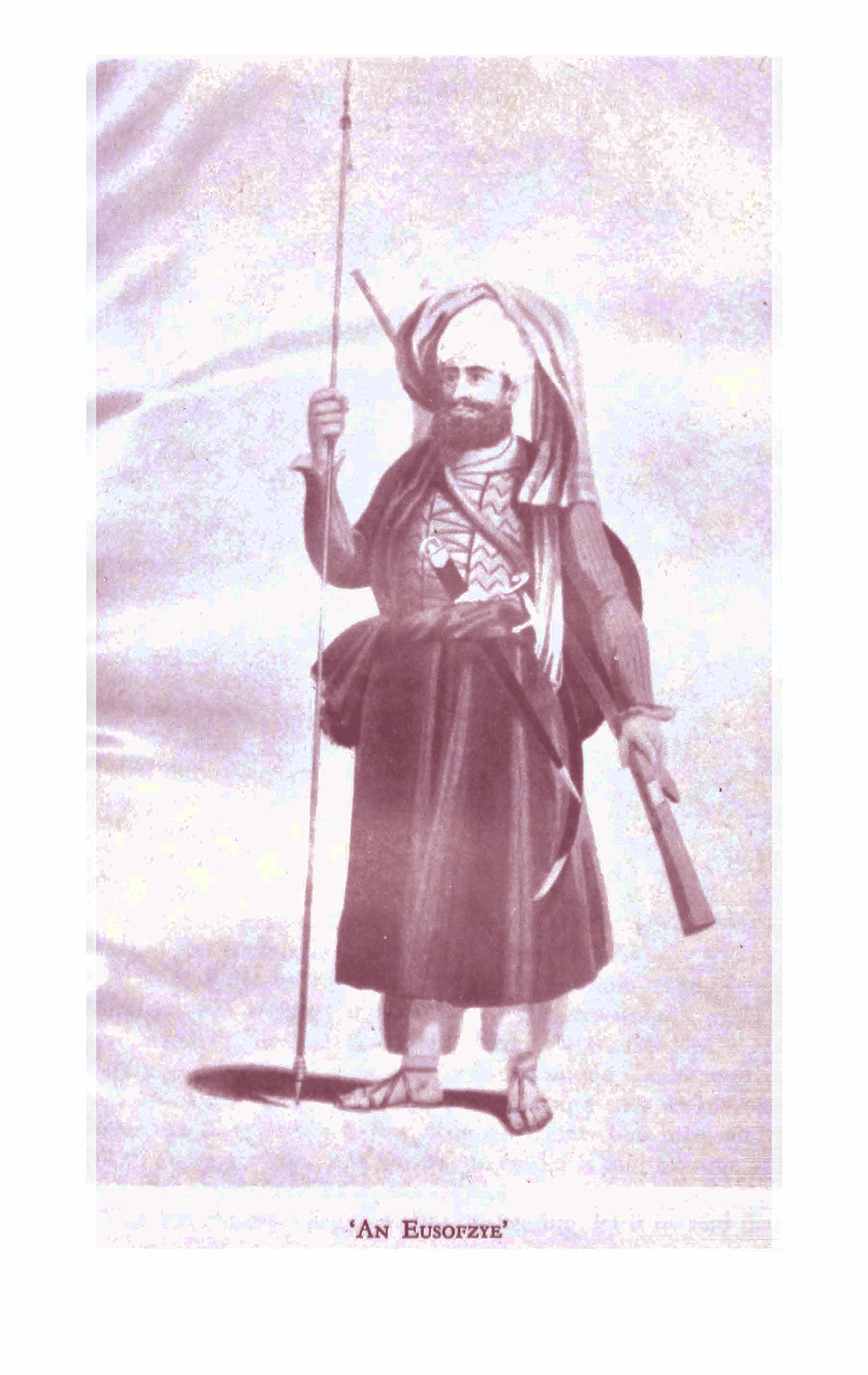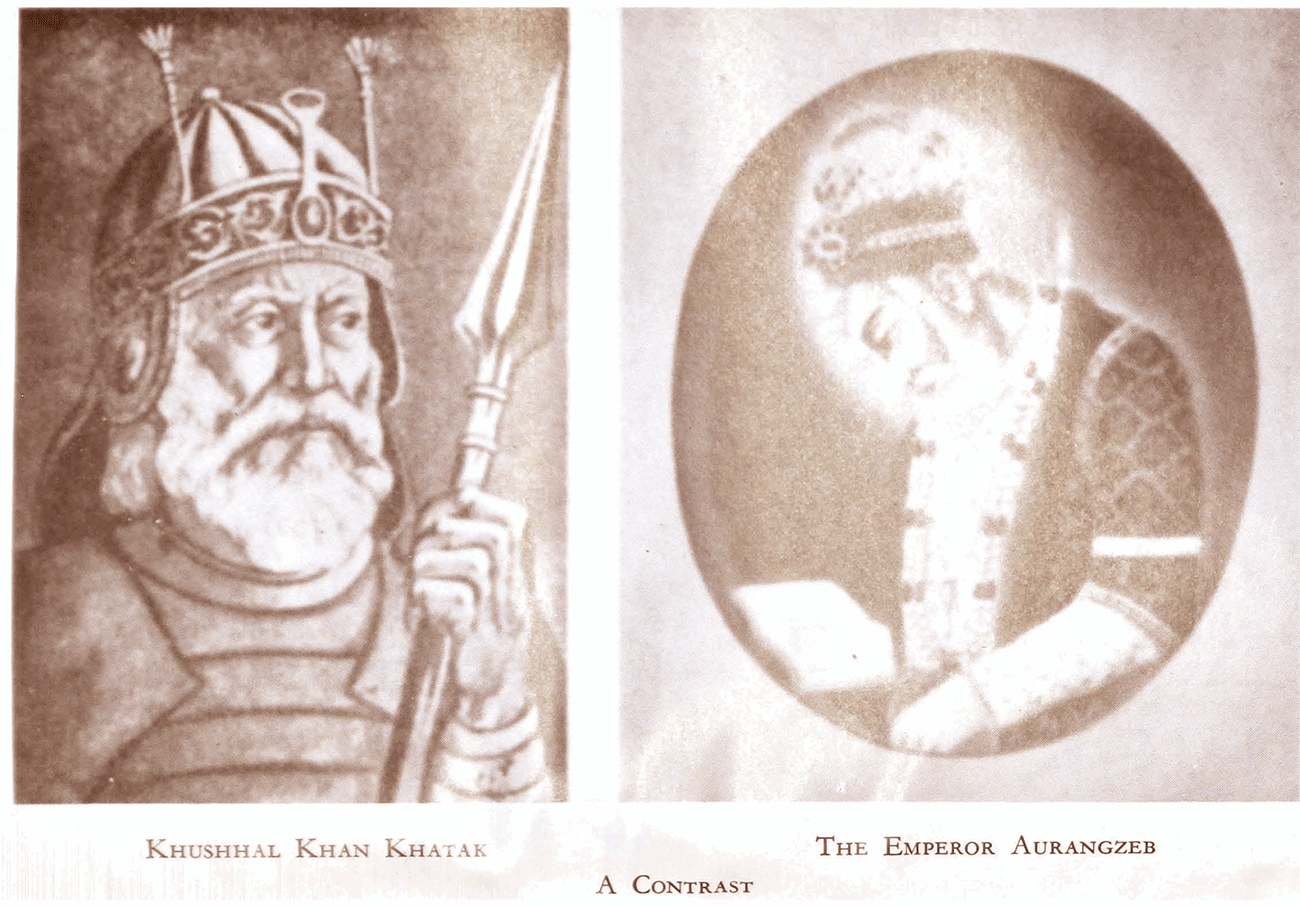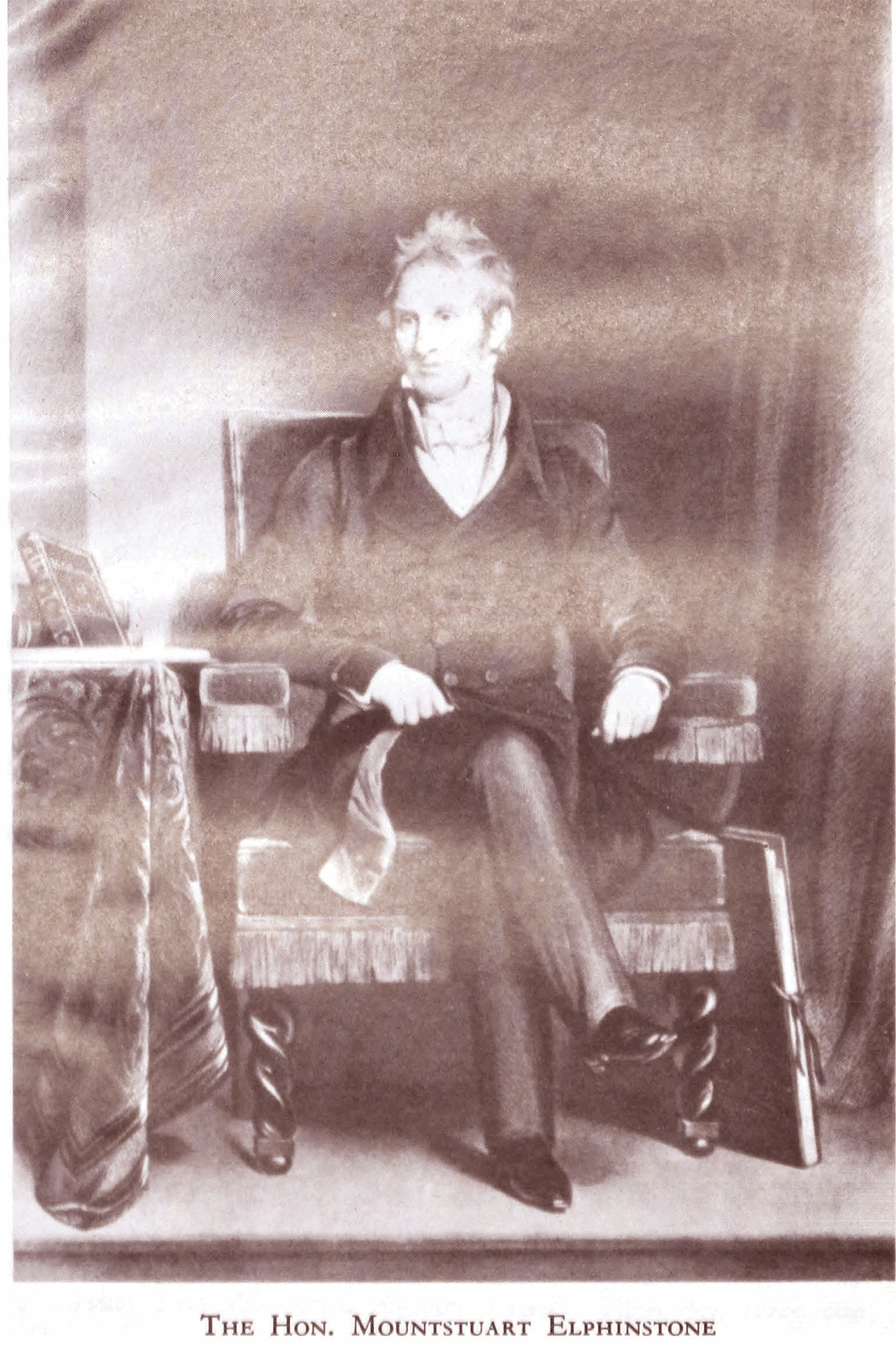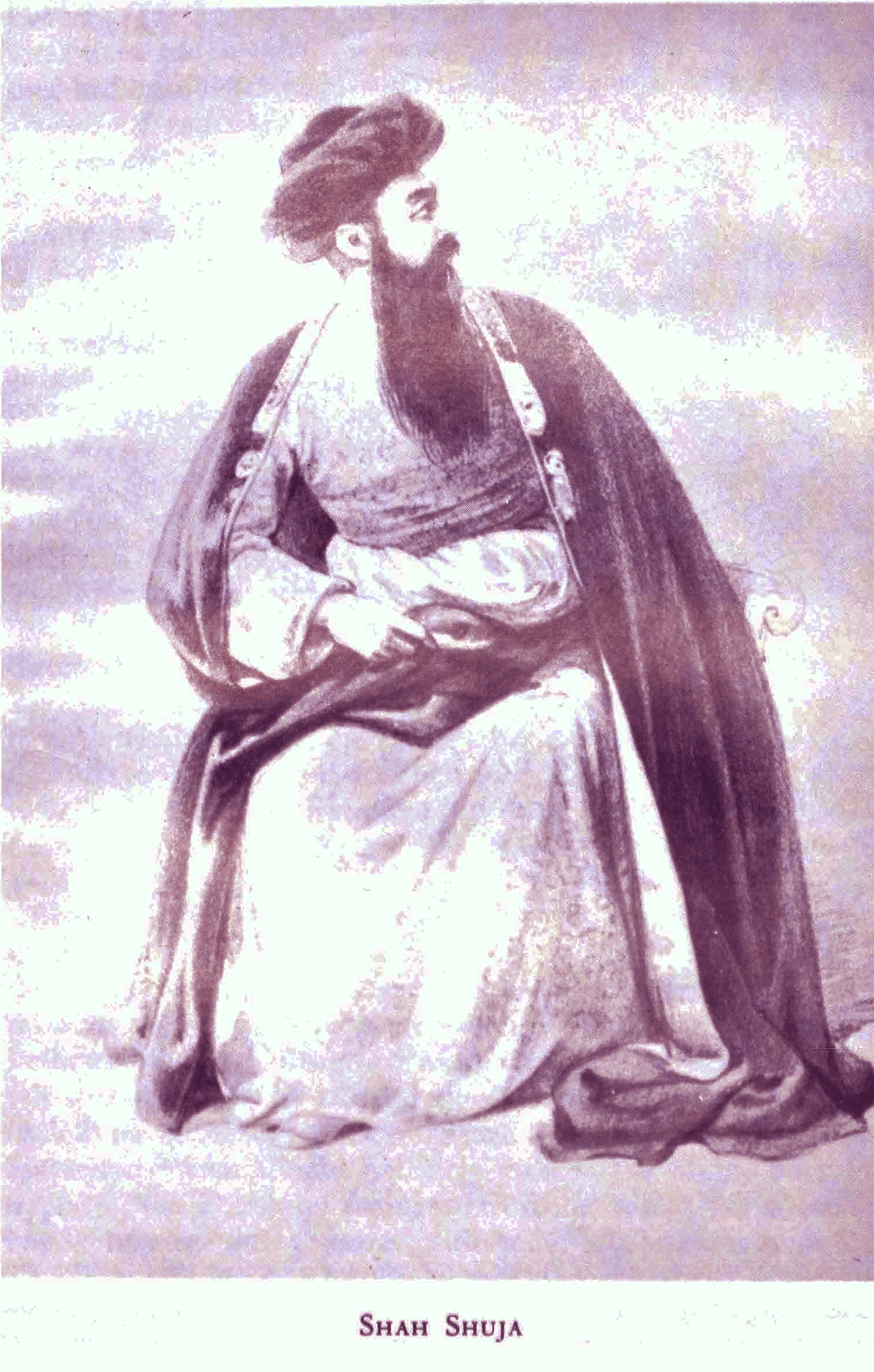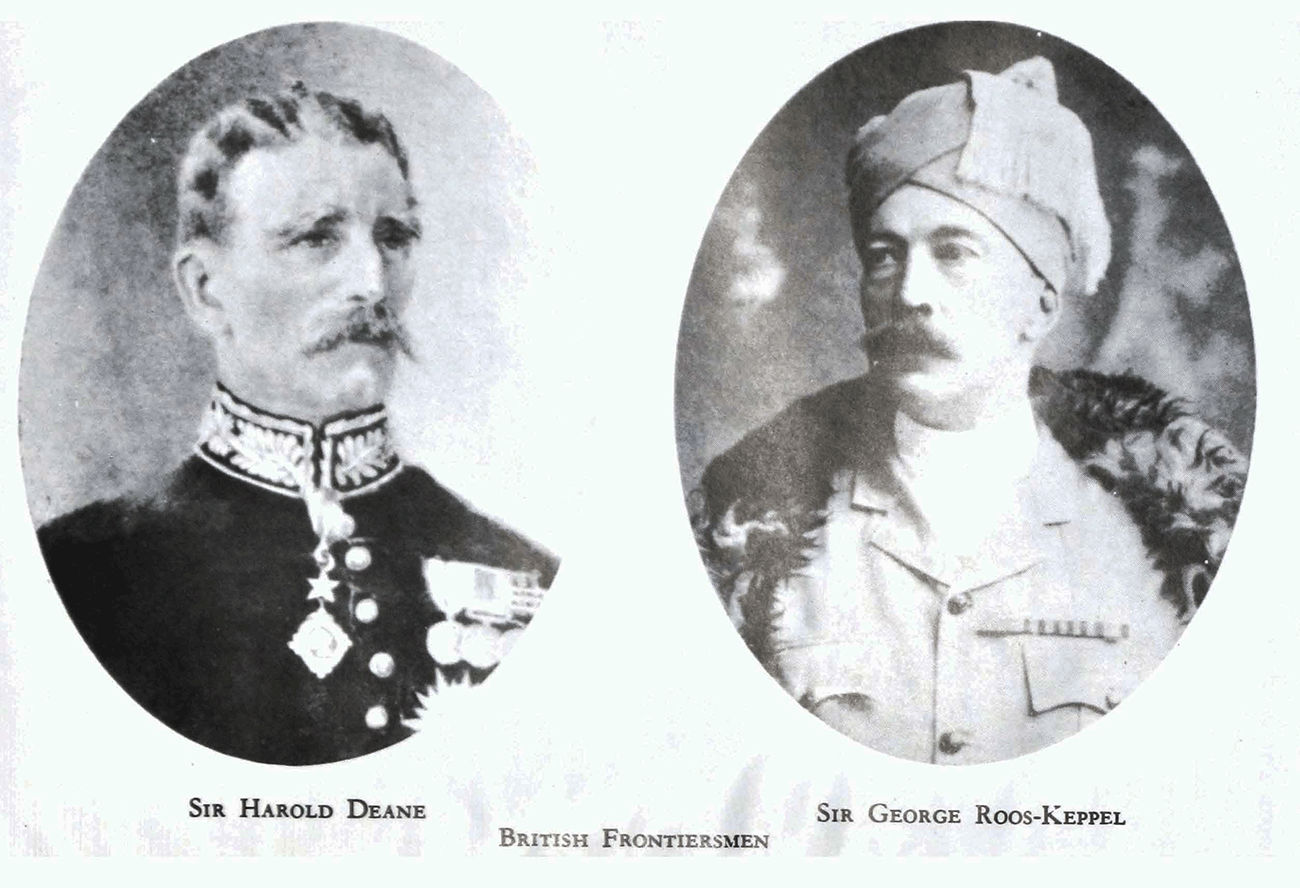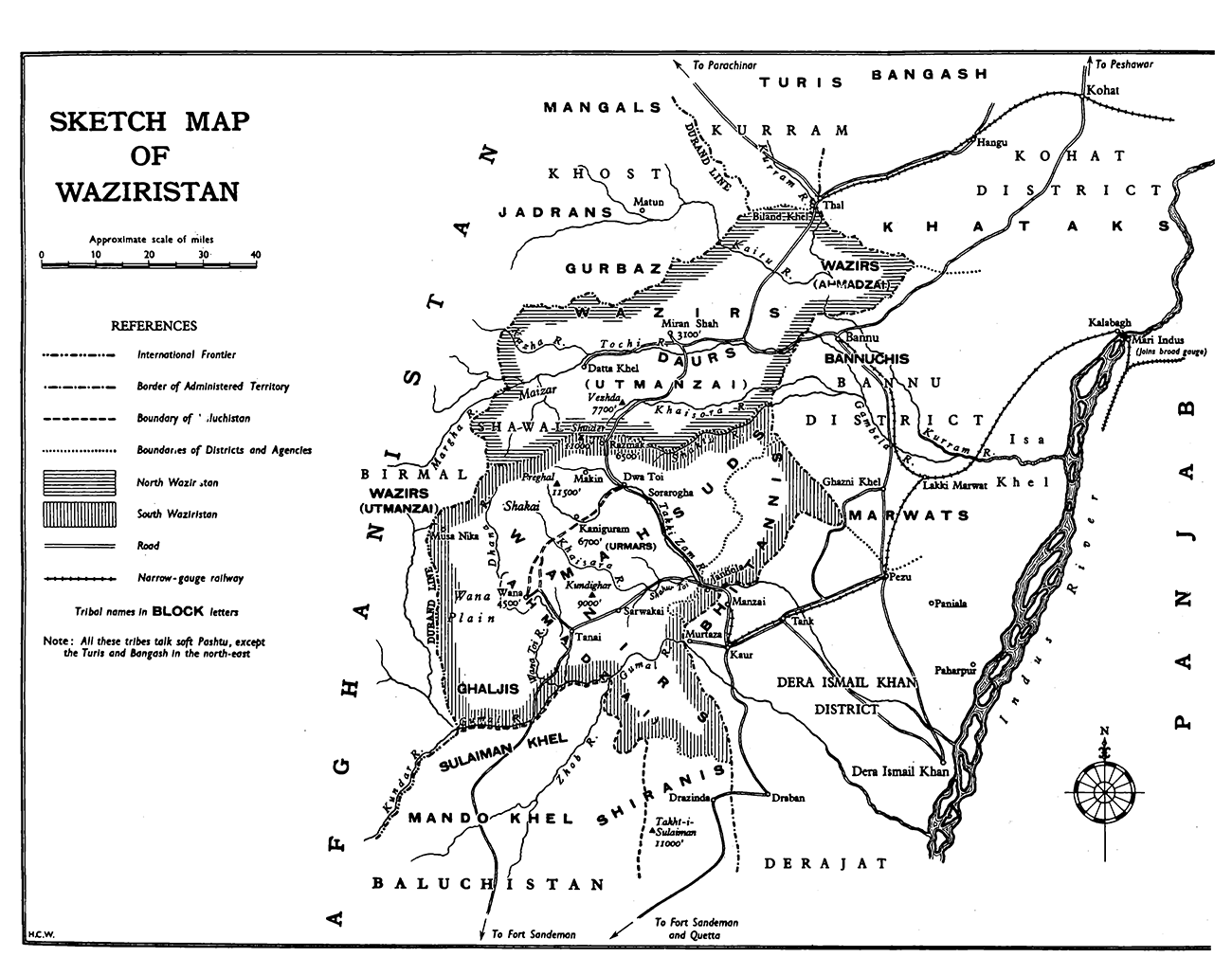 |
READING HALLTHE DOORS OF WISDOM"THIRD MILLENNIUM LIBRARY" |
 |
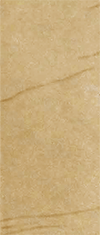 |
THE PATHANS
550
B.C.—A.D. 1957
BY
OLAF CAROE
FOREWORD
This is a book I was bound to write, at some time or the other, having
had the fortune to spend half a lifetime among Pathans. But with the
passage of time, from 1947, memories receded and the purpose weakened.
That the purpose revived was owing to the initiative and courtesy of
the then Government of Pakistan who made it possible for me, after nine
years’ absence, to revisit familiar scenes, meet old friends and make new
ones, and put in order against the new foreground a store of knowledge and
impressions acquired over more than thirty years. The result presented
is wholly mine; the responsibility for each conclusion, for every
emphasis, individual and unshared.
Tne voyage is long and the seas for the most part uncharted. For
example, I have sought to cover more centuries before the Pathans embraced
Islam than those which have since elapsed. If sometimes the touch may seem
uncertain, the answer is that it is not easy for one navigator
to encompass all the techniques, or indeed all the languages, needed
to fit together a chart, or manage a crew, over a space of 2,500 years.
For the pre-Islamic period and the earlier Islamic centuries I enjoyed
the devoted help of Dr. A.D.H. Bivar, formerly my aide-de-camp, sometime
Scholar of Corpus, and lately Research Lecturer in Ancient History at Christ
Church, Oxford. Without his enthusiasm ana expert scholarship this
part of the book could never have taken so distinct a shape. With his aid
I was able to interpret many original texts, Greek, Arabic, and Persian,
and to apply the results of specialized numismatic and epigraphical
studies. But here too — he would wish me to affirm — the conclusions are
my own and may not always stand up to academic assault, if that be
so, I must plead the licence of the non-specialist and a determination not to
permit the wood to be obscured by the trees.
Much more than formal acknowledgement is due to my friends, Evelyn
Howell, on whose earlier work hangs my picture of the tribes of
Waziristan, Ralph Griffith, who knew the meaning of Pathan honour, and
George Cunningham, ten years Governor in Peshawar, who read the whole work
in manuscript and blessed it with the criticism which does not confound.
From Pathans I received countless impressions of tradition and wisdom:
memorable among these are Sayyid Abdul Jabbar Shah of Sitana, who died in
1956, and that grand old man, Muhammad Zaman Khan of Akora, descended from
the most famous of Pathan poets.
To Mr. Zuberi, then Commissioner of Peshawar, and to Roger Bacon and his
staff at Mardan, I am in debt for contributions to the study of that same poet,
and to Mr. Ikramullah, then High Commissioner for Pakistan in London, both
for light shed on some dark corners of history and for his unfailing
encouragement in moments of doubt and difficulty.
In some sense this book was planned as the spark struck off by a century
of clash and contact between Pathan
and Englishman: though critics, some of them
constructive, have not been wanting, it has brought me a satisfying succs
d’estime, has been acclaimed both as a work of literature and of
scholarship, and has won me both a Doctorate of Letters at my own University of
Oxford and a Fellowship of the Royal Society of Literature. Although deeply
grateful for these honours, I have been even more concerned to stimulate
the further study of Pathan writers of their own origin and in this
respect too my efforts have had some success though the fact that this
book continues to retain its place as a standard work would seem to
indicate that further efforts are required.
When it was first written, there was little in the procession of Pathan
history over the centuries to indicate the imminence of Russia, whether Tsarist
or Soviet, from beyond the Oxus. Since publication the equipoise has been
upset. The power and prestige of Britain in India, consolidating
the strategic frontier established to the northwest by the
Mughal Empire which preceded us, exists no longer, and the Afghan State,
only established by Ahmad Shah in 1747, may not survive. Moreover, the Pathans
are tied to Afghanistan by bonds of race, religion, and language, and any
disturbance of the balance will have an effect both on the North West
Frontier itself and in the partitioned Subcontinent as a whole.
The Frontier peoples and the Afghans too are perhaps now
more conscious of their Islamic ties than ever before. And,
finally, any disturbance of the balance in this strategic part of
Asia will affect the stability not only of the Subcontinent itself but of
South Asia as a whole. Oil and communications are under threat.
Mr. George Chowdharay-Best and myself have therefore sought to attempt a
fresh assessment of these issues in an epilogue appended to this volume.
O.C.
September 1980
NOTE
To those unfamiliar with the North-West Frontier the tribal pattern of
the Pathans is hard to follow. A map showing tribal boundaries and
locations will be found at the end of this book.
CONTENTS
Introduction
THE ORIGINS
550 B.C.-A.D.
1957 (H. 391)
·
I.
The Genealogies
·
II.
The Greek Historians
·
III.
The Passing of Alexander
·
IV.
The Birth of Pakhtu
·
V.
Sakas, Kushans and Persians
·
VI.
The White Huns
·
VII.
Arab Expansion
VIII.
Saffarids and Hindushahis
PART II
THE MUSLIM
MIDDLE AGES
·
A.D.
1000-1707 (h. 39I—1119)
·
IX.
Mahmud and the Khaljis
·
X.
Sher Shah Sur
·
XI.
Babur
·
XII.
The Peshawar Tribes
·
XIII.
Orthodox and Heretic
·
XIV.
Akbar and the Tribes
·
XV.
Khushhal Khan and Aurangzeb
PART III DURRANIS AND SIKHS A.D. 1707-1849 (H. III9-I266)
CHAPTER
· XVI. Ahmad Shah · XVII. The Saddozais and Mountstuart Elphinstone XVIII. Ahmad Shah Brelwi and the Sikhs · XIX. The Dost and the Peshawar Sardars PART IV
THE BRITISH PERIOD AND AFTER
A.D.
1846-1957 (H. I263-I377)
· XX. The Paladins · XXI. The Close Border Policy · XXII. Ambela XXIII. Baluchistan and the Forward Policy · XXIV. Waziristan3 · XXV. North-West Frontier Province · XXVI. The Pathan Renascence4 INTRODUCTION
There is a strange fascination in living among the Pathans. Many
attempts have been made to catch and convey that feeling, but the spell is
elusive. One secret of the hold of
‘The life of a frontiersman is hard,’ wrote Ronaldshay, ‘and
he treads it daily on the brink of eternity. Yet, despite its obvious drawbacks,
the fact remains that these endless ranges of rugged rocks rising from
lower levels do possess the power of inspiring in those whose lot is cast
among them an extraordinary enthusiasm. ... I do not suggest that the
average warden of the marches habitually subjects his feelings to this
kind of analysis, but the circumstances of his life are such that he frequently
experiences the species of spiritual exaltation induced by solitude amid
the grandeur of nature, and such experience is one of the factors that go
to make the magic of the Frontier.’
But the land was made for the men in it, not men for the land. For the
stranger who had eyes to see and ears to hear, always as he drove through
the Margalla pass just north of Rawalpindi and went on to cross the great
bridge at Attock, there was a lifting of the heart and a knowledge that,
however hard the task and beset with danger, here was a people who looked
him in the face and made him feel he had come home. Yet, after a hundred
years and more of close contact, the Pathan remains to the world, and
even
In a word the truth is that the history of the Pathans has never been
unrolled. There are tribal annals, there is legend, there is myth. There
is also a wide and detailed record of brilliant achievement by Pathan captains
and kings far from their own land, even to the rank of empire at Delhi. There
is the uncertain Afghan Kingdom of the Durranis, but that was founded only
two hundred years ago and is but an episode in a long story. Although
the Pathans have stood for centuries in the corridors between Khurasan and
the Indian sub-continent just at the very point where great civilizations
have met and contended; although their mountain homes have been swept by
conquering armies again and again, to rise like a breakwater from the sea;
although the conquerors have passed on to found great empires — yet the
Pathans who hold the gate have never been given a vision of their own
story in perspective. In the modem sense there is no connected history
of the Pathans in their own land, whether written by themselves or by
any of those through the ages who passed by.
What, for instance, is the difference between Afghan and Pathan? Who and
what are they, and what their origins? What has been their social and
political organization through the centuries, and have they succeeded in
establishing a State? What is their language and what their literature?
And how have they stood to the uncounted powers and principalities which
at various periods of history have pressed upon them? What in the past
has been their influence on affairs, what are their auguries for
the future? These and a host of questions remain unanswered.
I do not wish to anticipate conclusions here. Distinction and definition
will emerge in due place as the story unfolds. But something should be said on
the use I shall make of the terms Pathan and Afghan, often loosely
employed by themselves as synonymous.
When we come to examine origins, it will be found that a clear
distinction can be drawn between those who inhabit plains and open
plateaux on the one hand and the highlanders on the other. The former have
always been regarded as the senior branch of the race and peculiarly
entitled to the Afghan name. They again can be broadly divided into (1)
the Western Afghans, of whom much the most important are the Abdalis (now
known as the Durranis)
The Western Afghans have been subject in history to certain Persian
influences which have affected the Durranis even to their language. Their
contacts and development lay with the Safawi Empire of Persia, and Herat
and Kandahar were their cultural centres. The Eastern Afghans, whom
Elphinstone and other early writers called ‘Berdooraunees’, are less
amenable to the Persian tradition, partly because their contacts lay with
the Mughal Empire which ruled from Delhi in Peshawar and Kabul. But
both, Eastern and Western, are equally entitled to the Afghan
name, which has a connotation far wider than that of a subject of
the modern Afghan State, founded only in 1747.
In between the Eastern and the Western Afghans, and to some extent
keeping them apart, are interposed the highlanders. These include most of
the famous names of the North-West Frontier. Afridi, Khatak, Orakzai,
Bangash, Wazir, Mahsud, Turi — all these strike a chord in countless
memories. The dialects of these tribes have something in common, and all are presented in genealogical legend as descended from a foundling
common ancestor named Karlanri, not in the true Afghan line. These are
preeminently the Pakhtuns, or Pashtuns. They are the tribes who never fell
under the effective sway of any recorded imperial authority and now form
the backbone of the so-called tribal belt.
These hill Pathans — the appellation Pathan is the Indian variant of
Pukhtanah, the plural of Pakhtun — have always traded with the cities and
towns towards the Indus, and not with Kabul or Ghazni to the west.
Consequently their links with the Eastern Afghans of the Peshawar Valley
have been much closer than with the Durranis or other tribes inhabiting
the country to the west, which they know as Khurasan. Conversely the
Eastern Afghans feel an undoubted sense of identity with the hill-tribes,
a sense which has hardly as yet attained to any concept of unity
but transcends tribal particularism. In a very broad way, and
with some local exceptions, the Eastern Afghans and the
highland Pukhtanah, their brethren, all live east of the Durand Line, within Pakistan as the successor State of the British in India.
It is chiefly of these, the Eastern Afghans and the highland Pukhtanah,
that I write in this book, but without exclusion of
Yet another distinction is necessary at the start. Every student of
current political jargon is confused by the variants Pakhtun and Pashtun.
It is common and confusing practice to refer to the language Pashtu spoken by
Pukhtanah in an imaginary Pashtunistan. There are two main variants of the
language of the Pathans — and Afghans, when they are not Persian-speakers
— the Pakhtu spoken by the north-eastern tribes, and the Pashtu by those
to the south-west. (There are of course many other differences in the
two main variants in addition to that of kh, sh.) The line of
division between the two runs roughly east and west from the Indus
just south of Attock through Kohat, up the Miranzai Valley to
Thai, and thence south of the Kurram River to Hariob and the Shutar-gardan
pass. North-east of that line the hard language is spoken. This is the
tongue of all the Peshawar tribes, of Dir, Swat, Buner, and Bajaur, of the
Afridis, Orakzais, Shinwaris, Bangash and Turis.
South-west of the line and speaking the soft variant are all the
Durranis, almost all the Ghaljis except a few near Jalalabad, all
the tribes in Khost and Waziristan, as well as the tribes of Bannu
and the Derajat, many of them with Ghalji affinities. The Pathan
tribes of Zhob and other parts Baluchistan close to Kandahar
also speak the soft variant.
One tribe only is split in half between the two, the Khataks. The main
body of this tribe, living south of Kohat, speak Pashtu, but the Khataks
of Akora and Mardan, round about Khushhal Khan’s time, became assimilated
to the Yusufzais and now speak Pakhtu. Most texts of the poems of Khushhal
Khan Khatak, the most renowned of Pathan poets, were edited and
lithographed in Peshawar, and are therefore in Pakhtu. But his descendants
affirm that Khushhal’s original script was in Pashtu — a tradition
supported by the historical fact that his tribe’s encroachments into the Yusufzai
country, and their assimilation to Yusufzai ways, took place no earlier
than Mughal times. We may accept the Khataks own tradition that
originally they were all Pushtanah, speaking the soft variant of the
language. Nevertheless the later emergence of the northern Khataks as
Pukhtanah is not without its significance as demonstrating the
assimilative power of Pakhtu over Pashtu.
The geographical distribution of the two forms of the language
There is a further tribal distinction, which almost follows the line of
division between Pakhtu and Pashtu in the Karlanri hilltribes. The
Pakhtu-speakers wear their hair clipped short, often shaved; the
Pashtu-speakers, except in the sophistication of towns, favour a chevelure
falling around the ears, varying from the neatly combed and curled bob of
the Khatak soldier to the ragged ringlets of the Mahsud or Wazir. This long
bobbed style is known as the tsanrai, cut clean at the ear but shining and
curled above it, parted in the middle and sometimes held in place with
little wooden clips. And, for greater interest, it is the men of the
long hair, the speakers of Pashtu, and they alone, who dance, the tsan-rai
spinning as they whirl around. Peter Mayne’s recent book carries
a haunting description of such a scene — the stir and throb of beating
drums, the dust, the wild eyes, the flickering fire and flashing swords,
the elation. Khataks, Mahsuds and the tribes of Khost are pastmasters at
this art.
Geographically the Pathan country is hard to describe, even with a map.
It is best seen as a long narrow fortification running parallel in two
belts, first a moat and then a rampart, along the line of the Indus which
here runs almost north and south, with a slight trend towards the west.
Towards the south the rampart stands back much further from the river.
Behind the rampart begins the great Iranian plateau which, except through the
Sulaiman Mountains, has no drainage to the sea.
The first belt is made up of plains and valleys along the river; the
second, standing over the valleys, is the great transept of the Sulaiman
Mountains running southward from its apex in the mighty ranges of the
Hindu Kush where they culminate on Tirich Mir. At many points
this transept thrusts forward fingers towards
The Sulaiman chain runs roughly north-east and south-west, but has many
divagations. The most important of these is in its highest part, the Sufed
Koh, where it rises in the Sikaram peak north of the Kurram to
over 15,000 feet and, running due east and west, forms part of the Durand
Line. This escarpment of the Sulaiman system is the geographical
eastern’front of the Iranian world, turned towards India. Across it there
has been much ebb and flow, but in the result the Iranian scene, and
Iranian man, have spilled beyond this eastern limit and prevail as far as
the Indus, and even beyond — some would say up to Lahore. But to him
who approaches from Lahore the unmistakable change of atmosphere is
felt, as I have said, at Margalla, forty miles before the crossing of the
Indus and close to the site of ancient Taxila. Here he will smell the
scents of the homeland as a voyager putting out from France knows he is
in England when he sights the cliffs of Dover. This is the Pakhtun Khwa,
the land of the Pathans.
Later, after crossing the splendid river swirling through the gorge at
Attock, he will find himself in a spreading vale, watered by many streams
and surrounded by an unbroken girdle of mountains. The hills that stand around
Peshawar not only look like a ring; they are actually set on the map in a
circle, almost complete but for one segment in the south-east where the
valley-lands slope to the banks of the Indus. This valley has four doors,
one by which we have entered without, need to cross a pass, and three
of exit over the mountains. These three are the passes of
Khaibar, Kohat and Malakand. The Khaibar lies straight ahead to the
west, opening beneath the prominent cone of Laka Sar in the
Tahtarra range. It leads to Moscow by Kabul. The Kohat pass —
known always as the Darrah, or the Pass — is in the south-west. It
crosses the knuckle of the finger which closes the ring to southward
and carries the lateral road which gives access to the southern
districts of the Frontier. The Malakand is to the north. It pierces the
first range and opens the way into the paradise of Swat, leading thence
Two great rivers, the Kabul and the Swat, cleave the western segment of
the circling hills by gorges too narrow for roadways. On entering the
valley the two rivers split into five channels, which reunite lower down
to form the Landai — the Short River — and pour their Central Asian waters
into the Indus just above Attock. The volume of the united stream is
nearly as big as that of the Indus itself. The course of the Swat River
presents a geographical phenomenon. Just north of Malakand, where it is
separated from the Peshawar plain by only one low range, it flows from
east to west. But, failing to break through here, it enters a series
of deep gorges through which it runs in a U-curve, and after receiving the
Panj kora in due course enters the plain from the west, flowing in an
opposite direction. What nature failed to do man has done. The Malakand is
pierced by a tunnel carrying the Swat water direct into the valley for
irrigation and supplying waterpower to run the Frontier industries.
In such a land the variations of climate and scene are extreme. In
winter and spring nothing can be more delightful than the lower valleys
and plains. The genial winter sun shines, the breeze blows clean and sharp
from the snows, it is a joy to live. In a land of streams and rivers
villages nestle half hidden in groves of sheltering trees. Broad stretches
of verdant wheat, barley and clover, alternating as the seasons change
with giant crops of sugarcane and maize, spread a picture of rural plenty, to
be equalled possibly but never surpassed in the length and breadth of Asia.
There is an intimacy about these scenes which grows the more
frequently they are visited.
In the north the great plain of the Yusufzai Samah, once
arid waste, has been turned into fertile corn-lands watered by
canals. Close under the hills, and side by side with canal-irrigation, the
old indigenous well-cultivation proceeds, the shaded wells, the creaking
wheels, the plodding oxen — dear, familiar places, lending the countryside
the charm peculiar to this ancient form of husbandry.
The Khatak fringe of hills to the south is bare and rather commonplace, but provides a platform for what must be the most extensive mountain panorama in the world. Distance and perspective is given by the sixty miles of the Peshawar plain which, lying in the foreground like an Attic stage, leads the eye on to a vast back-curtain of everlasting snow. Seen from Cherat in the cold, clear light of a winter day, the great plain with its converging rivers and rectilinear canals — both shot to silver here and there as the day revolves — this and the amphitheatre of surrounding hills, backed in the north by the chain of giant mountains, provide a prospect of splendour not easily forgotten. In the far north sprawls the mass of Tirich Mir; north-east, perhaps 120 miles away, the mighty breast of Nanga Parbat, stark and gleaming, challenges the sky. In summer, though still verdant with the crops of the season — maize,
millet, rice and growing cane — the valleys swelter in a steamy heat as
uncomfortable as any in the world. The unwatered tracts and the thorny
half-deserts of the lower hills at that season provide a foretaste of the
regions of the damned. Yet such is the sharpness and salt of contrast that
at the very height of the hot weather a few hours’ journey will take the
sufferer to forest glades and alpine pastures where he can find again the
climate of an English summer.
For further contrast, in many tracts at certain times of the year there
is a stark ugliness, well described in that same recent book as
‘a sullen hate, not the keen, glittering hate that everyone enjoys . . .
mountains brown like snuff, ten-thousand foot mounds with the track
snaking its way through for mile on heavy mile’. That was written of the
road to Kabul, but it might apply equally to some journeys through
Waziristan or in the desolation of Zhob. But then, suddenly, the landscape
opens out — there is a trickle of water, a group of trees, a garden — and
there comes a sense of rare fulfilment. To get that feeling a man should
travel north from the burning boulder-strewn hills and torrent-beds of
Thai in Lower Kurram. In a couple of hours he may find himself dreaming in
paradise beside the planes and willows that line the streams tumbling with
the noise of constant water from the snows of the mountain-wall above
Parachinar.
The western of the two belts of territory making up this Frontier lies
wholly in the mountains between the administered border and the political
boundary known as the Durand Line. Part of it indeed overlaps the Durand
Line. It starts with the escarpment mentioned and rises to highlands in
some places carrying peaks from 10,000 to 16,000 feet in height. Almost
everywhere the foothills are bleak ahd uninviting, hard and craggy,
The authority of the various empires which claimed in the past to rule
this Frontier really only extended to control over the plains and one or
two of the passages through the mountains. Only the greater Mughals seem
to have thought it worth their while to make a serious attempt to bring
the hill-tribes under domination as subjects, and, as we shall see, they
failed. Even passage by a main route through the mountains had often to
be asserted by force and with difficulty against the refractory
tribes which held the road in use at the time. An understanding of
this fact explains the escape of this tribal belt as a whole from
subjection to any external power — a freedom symbolized by the failure to
impose in it any taxation. This, too, is the reason why a tribal form of
society has persisted in a country which lay across the passage of countless
invaders, including Alexander, Chingiz Khan and Tamerlane, the most famous
conquerors in all history.
But there is another side to this medal. This very freedom, enjoyed over
the centuries by the heart-lands of the Pathan, denies to the enquirer all the
usual raw material of history. Until 1747 there was no local principality;
therefore there are no records or coins except those of the empires on
whose fringes the tribal belt lay. Even the language oi the Pathans does
not seem to have been reduced to writing until the fifteenth century, and
there is no extant literary work known to be genuine earlier than the
seventeenth. Therefore there are no chronicles available until
relatively modern times. The Pathans did not build monuments or write inscriptions
in their own country. Therefore there is no epigraphical material. It follows
that the historian must rely on stray and chance material available in the
records, inscriptions, literature, monuments and coins of the many dynasties
and peoples whose path took them across the territories where the
Afghans and Pathans now dwell, wherever possible adjusting the results
of his labour to the record and tradition, often oral, of the
Pathans themselves. The most he can hope to do is to blaze a trail
which others, with growing knowledge, may follow and improve.
The prologue is spoken and the curtain goes up. I must not further delay
the play. One thing only would I add here. The persistence of the Pathan tribal
tradition has produced a society at all levels, starting from the nomad
and herdsman, through the articulated tribe and the sponsors of an Asian
dynastic principle, to the modern lawyer, engineer, doctor, administrator
and politician. Standing over against the tribal village and the tents of
the caravan are men for a century imbued with Western thought and
now reaching forward to that synthesis of values which
Pakistan strives to attain. All these stages of social and political
development can be seen today, side by side and superimposed one
on another, by anyone who cares to move in a twenty-mile radius around
Peshawar. By so doing it is possible to enjoy daily a bodily translation
into earlier phases of human society and life — a wonderful occasion for anyone
endowed with historical instincts. We have here what John Morley called a
congeries of peoples engaged in a long march through the centuries from
the fifth to the twentieth. To be in a position to observe all this, relatively
undisturbed by the influences of our complex life, is a vastly exciting
experience.
It is a part of the magic of the Frontier.
|

